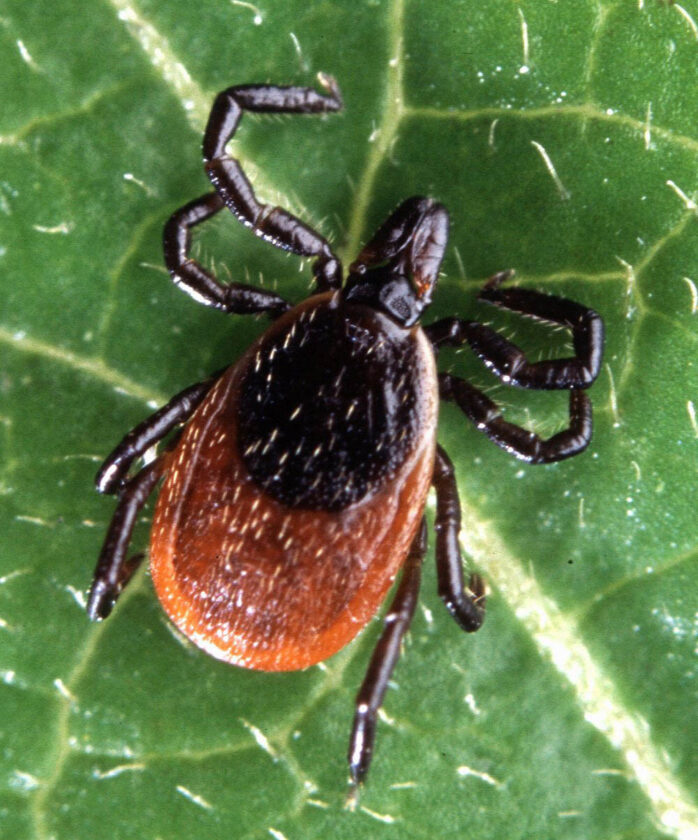‘Here to stay’
Learning to live with the risk of ticks

This adult blacklegged tick, otherwise known as a deer tick, is less than a quarter-inch in length. (Provided photo — Scott Bauer, Wikimedia)
Once upon a time, the Adirondacks were known as somewhat of a safe haven from ticks, and consequently, tick-borne illnesses. However, that is no longer the case. Here’s what local health experts want the public to know.
The two most common tick-borne diseases in this region are Lyme disease and anaplasmosis, which are both spread by the deer tick.
At a state level, cases of Lyme disease have skyrocketed. According to CDC data, the average number of Lyme disease cases between 2008 and 2022 in New York was 4,227. But in 2022, cases jumped to 16,798 from 3,006 the previous year. In 2023, the most recent year with data available, there were 22,173 cases.
The Adirondack Park is still the only region listed as having a low risk of Lyme disease, according to information from the state working group on lyme and tick-born diseases. However, this doesn’t mean there aren’t cases here.
Andrea Whitmarsh, program coordinator at the Essex County Health Department, said the county has seen an increase in Lyme disease over the past 15 to 20 years, meaning that health providers have had to become more familiar with its symptoms and treatment. There has also been an increase in anaplasmosis, a bacterial disease that can also cause a range of flu-like symptoms.
The health department has noticed that there are more cases of tick-borne diseases in the population over the age of 60 than any other age group. In this age category, there were 51 cases of Lyme disease in 2022 and 99 so far in 2025. Similarly with anaplasmosis, the county saw 12 cases in 2022 and 70 so far this year.
Whitmarsh said the reasons for the high prevalence in the older age group is unclear, but said they’ve explored numerous age-related factors, such as spending more time outside in retirement or having more trouble seeing and removing ticks.
–
How to stay safe
–
The challenge of tick-borne illnesses, Whitmarsh said, is that the risk is hard to eliminate completely.
“If you’re outside, you’re going to come in contact with these bugs,” she said.
As such, the health department focuses their energy on prevention and raising awareness about ways to reduce risk. The first strategy is to take away opportunities for ticks to make their way onto your skin. This can be done by covering skin with long sleeves and pants, treating skin or clothing with repellent and avoiding areas that are particularly attractive to ticks — places that are shaded, relatively wet or areas with long grass.
A daily check goes a long way, Whitmarsh said. The most important factor in preventing disease, if bitten by a tick, is to remove it as soon as possible. She noted that having someone help you can be good if you have trouble seeing or reaching all areas of your body.
“Early detection and treatment really is important,” she said.
Lee Ann Sporn, a biologist at Paul Smith’s College, has worked closely with the state to monitor ticks and tick-borne diseases in the area. She added that it’s important to grab the tick by the mouth parts with tweezers and “pull it off in a steady motion.” Don’t squeeze its body, which will cause the bacteria to enter your body.
If you are bitten, Sporn said to mark the date on the calendar and take a photo of the bite in case you decide to go to the doctor. If you get a fever, or other flu or COVID-like symptoms in the weeks afterwards, go to the doctor and tell them about your bite.
For more information from the state about Lyme disease, visit tinyurl.com/rx97kscc. Information from Essex County can be found at tinyurl.com/bdeu69t9.
–
Warmer and wetter
–
Asked what is behind the increase in ticks and tick-borne diseases, Sporn had a simple answer: climate change. As the seasons have gotten warmer and wetter, ticks have more time to find hosts and reproduce. She started working on this surveillance around 2014 and has witnessed the explosion of both ticks and infections like Lyme disease.
“Our big thing was, in this area where ticks are emergent, people don’t know,” she said. “They don’t think there’s a risk, and there’s a big risk, so we got the word out as early as we could.”
Within the Adirondacks, there tend to be more ticks in lower and wetter areas, such as river valleys, Sporn said. Deer ticks are spread by their namesake mammal, but smaller animals play a big role in spreading ticks and disease. Animals such as mice, squirrels and chipmunks are what actually cause the ticks to pick up diseases.
It can be helpful to know the seasons that ticks tend to be most active, and Sporn uses holidays as easy-to-remember sign posts. Between Memorial Day and July Fourth, ticks are in the nymph stage, which is when they are actively feeding and can also most likely carry diseases.
Later in the summer, around this time of year, is actually the lowest-risk time because the ticks are in a stage where they are not actively feeding. Around Columbus Day, until the snow falls, the adult ticks are out and feeding again. Technically, no time of the year is completely free of risk, even during a January thaw.
“The ticks are active. They’re trying to feed anytime it’s not freezing, basically,” Sporn said.


